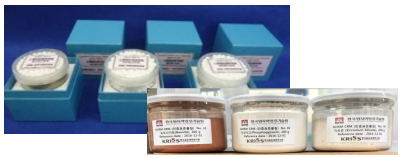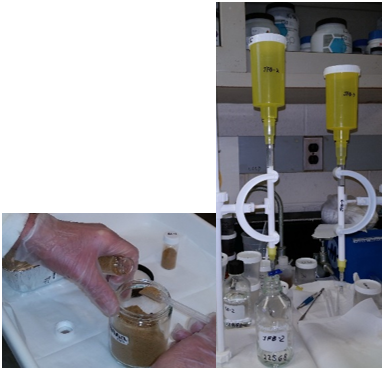Environmental: Natural Matrix Certified Reference Materials (CRM) Based on International Interlaboratory Comparisons
Summary
Reliable and accurate measurements of radioactivity in natural matrices are critical to key aspects of environmental research, including climate change, air pollution, soil erosion, radioactive waste management, and more. In addition to the presence of naturally occurring radionuclides, significant quantities of anthropogenic radionuclides have been introduced into the environment over years from atmospheric nuclear weapons testing, nuclear power plant releases, activities like phosphate recovery from minerals, fracking processes, etc. Furthermore, terrorists’ threats to use radiological dispersion devices (RDDs) and/or improvised nuclear devices (INDs) forewarn the international radioactivity community to develop reliable measurement systems based on standards and reference materials for instrument calibration and method validation.
Environmental monitoring of radioactivity based on reliable measurements informs both the general public and the policy-makers responsible for consequence management in the event of any radioactive contamination. This information must be based on accurate data produced by qualified laboratories and comparable between numerous laboratories for joint assessments. Large numbers of Natural Certified or Standard Reference Materials (CRMs or SRMs) have been created and made available for use. The radioactivity community continues to develop new reference materials based on international efforts to characterize and certify radioactivity content in different environmental matrices via intercomparison projects which involve experienced and internationally recognized laboratories.
Description

The CRMs are used by the radioanalytical measurements community for the assessment of radioanalytical methods, for equipment calibrations contributing to the accuracy and precision of analyses, and for providing traceability to SI standards. Reference materials are needed to evaluate and compare radiochemical measurement procedures, and to support the quality control and the comparability of measurement results among laboratories. They are also widely used for environmental studies such as soil erosion, ocean studies, freshwater discharge, climate change, etc.
Natural radioactive CRMs are usually products of national or worldwide intercomparison exercises to establish certified radioactivity composition of materials based on measurement results from all laboratories having participated in those efforts. A material that is chosen to be certified as a reference material is prepared by an internationally recognized institution and distributed to experienced laboratories for analysis. The intercomparison exercises allow competent laboratories to employ their own validated radioanalytical procedures. Such approach diminishes the possible bias by combining all the results and contributes to the continuous improvement of laboratories’ existing and developing analytical capabilities that consequentially promote participation in developing of new CRMs.
Natural matrix RMs are developed often from biological and environmental materials contaminated by events (e.g., Rocky Flats, Chernobyl, Fukushima) and/or radioactive fallout from old atmospheric nuclear weapons testing containing long-lived fission products (e.g., 90Sr, 137Cs) and activation products (Np, Pu, Am, Cm) in addition to naturally-occurring radionuclides such as 40K, Ra, 210Po, Th and U and their decay chains.
Gamma-ray emitting radionuclides may be determined non-destructively and destructively using gamma ray spectrometers with appropriate corrections for density and composition. Pure beta and alpha emitters require complicated radioanalytical procedures including sample dissolution, chemical separations, and sample preparation followed by beta counting, alpha, or mass spectrometry.
Some natural matrix reference materials characterized for radioactivity content of both natural and anthropogenic radionuclides have been produced at NIST:

- Sediments - from the Columbia River (4350B), a freshwater lake (4354) and ocean (4357)
- Biological – from human lung (4351), human liver (4352), bone ash (4356), ocean shellfish (4358) and seaweed (4359)
- Soils – Rocky Flats I (4353), Rocky Flats II (4353a), and Peruvian (4355)
NIST also interacts with other organizations around the world to maintain its expertise and to contribute to the certification of non-NIST reference materials. Completed examples of NIST participation in international intercomparison exercises (IICE) to develop natural CRMs are:
- Wild Berries contaminated by the Chernobyl accident (IRMM-426) – IICE organized by the Institute for Reference Materials and Measurements (IRMM) of the European Commission (EC) [2011].
- Japanese rice (JSAC-0731) contaminated by the Fukushima Daiichi nuclear power plant (NPP) accident -– IICE organized by the Japan Society for analytical chemistry (JSAC) [2013 – 2014].
- Japanese brown rice (JSAC-0732) contaminated by the Fukushima NPP accident - APMP supplementary international comparison APMP.RI(II)-S3 organized by the National Metrology Institute of Japan (NMIJ) and National Food Research Institute (NFRI) of Japan [2013 – 2014].
- Fish meat and fish bone ash contaminated by the Fukushima NPP accident - IICE organized by the Japan Society for Analytical Chemistry (JSAC) [2014 – 2015].
- Baltic Sea Sediment (IAEA-465) contaminated by Cold War Nuclear Weapon activities – IICE organized by the International Atomic Energy Agency (IAEA) [2018 – 2017].
- Three minerals of phosphogypsum, bauxite, zirconium silicate as Reference Materials for Naturally Occurring Radioactive Materials (NORM) – IICE organized by Korea Research Institute of Standards and Science (KRISS) [2018].
- Wheat flour harvested just after the accident of Fukushima Daiichi nuclear power plant - CCRI(II) supplementary international comparison (CCRI(II)-S13) organized by The National Metrology Institute of Japan (NMIJ) and National Agriculture and Food Research Organization (NARO) [2018].
- Shiitake mushroom powder contaminated with 137Cs – CCRI(II) supplementary international comparison (CCRI(II)-S15) organized by Korea Research Institute of Standards and Science (KRISS) [2021 – 2022].
Such reference materials continue to be made based on coordinated national and international efforts among the worldwide laboratories and organizations to avoid redundancy and to provide rigorous experimental investigation of the candidate reference materials.

